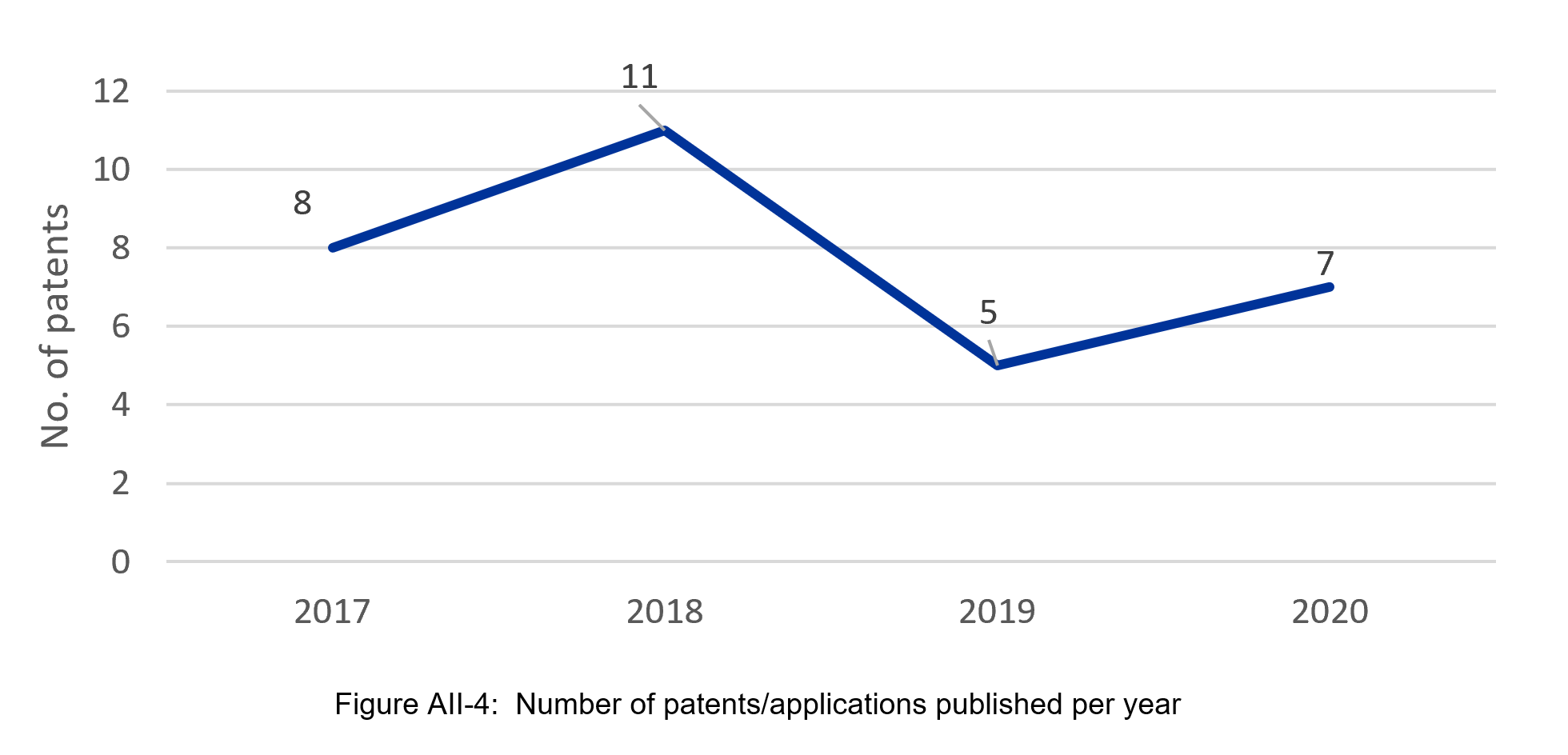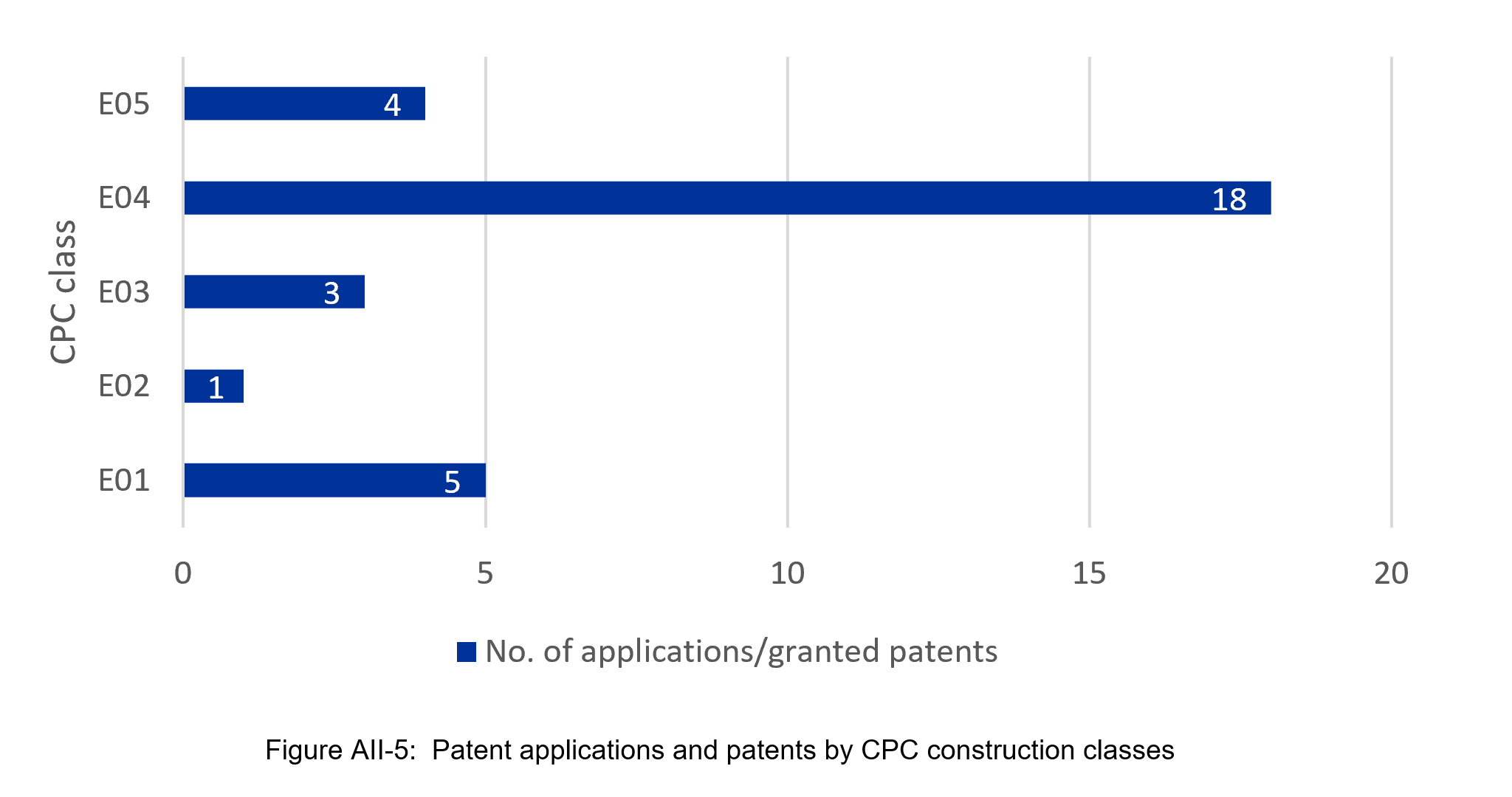Patents - EUON
Construction
Overview
This section looks at the patenting activity in the field of nanotechnology and construction from 2017-2020. Granted patents and patent applications focused on construction and nanotechnology were extracted from the general collection of nanotechnology patents from 2017-2020 developed by the study team for the database. The patents were collected from Espacenet database maintained by the European Patent Office.
The dataset of patents on construction and nanotechnology was developed by extracting the granted patents and patent applications that contained the CPC classes and sub-classes dedicated to construction in their bibliographic information. It should be noted that most nanotechnology patents contain multiple classes in their subject descriptions. In CPC construction is covered under E class (Fixed constructions).
| Table AII-2: Construction in the Cooperative Patent Classification (CPC)1 | |||
|---|---|---|---|
| Class | Title | ||
| E01 | Construction of roads, railways, or bridges | ||
| E02 | Hydraulic engineering; foundations; soil shifting | ||
| E03 | Water supply; sewerage | ||
| E04 | Building | ||
| E05 | Locks; keys; window or door fittings; safes | ||
| E06 | Doors, windows, shutters, or roller blinds in general; ladders | ||
Patents on nanotechnology in construction
As a result of patent collection mining, 31 patent applications and granted patents published in 2017-2020 were identified. The number of patents and patent applications in construction varied from year to year.

Most patents (20, 65%) were published in the national patent offices, while the rest were in the World Intellectual Property Organisation (WIPO, 10, 32%) and the European Patent Office (1, 3%).
China (10 applications, 32%) prevailed among the countries where most patent applications were published. Other countries, such as Russian Federation, the USA, Spain and South Korea significantly lagged behind China.
| Table AII-3: Countries by filed patents/applications in construction and nanotechnology in 2017-2020 | |||
|---|---|---|---|
| Country | No. of patents/patent applications, % | ||
| China | 10, 32% | ||
| Russian Federation | 5, 16% | ||
| USA | 2, 7% | ||
| Spain | 2, 7% | ||
| South Korea | 1, 3% | ||
Patent applications and granted patents contained five CPC sub-classes referring to construction. One patent application might combine several construction-related CPC sub-classes. The overwhelming majority of patents and applications focused on applications of nanotechnology in construction of buildings and their parts (E04, 18 applications and patents, 58%).

Patents dedicated to other fields were much less visible.
| Table AII-4: Examples of patents focused on E04 sub-class | |||
|---|---|---|---|
| Bibliographic information | Abstract | ||
| Ri, B. H. et al. (2018). Multifunctional Composite Building Materials and Construction Thereof. Patent no. WO2018124314A1. Available here. (patent application) |
Multifunctional composite building materials, which are obtained by mixing nano silicon dioxide, nano titanium dioxide, nano aluminum oxide and nano zinc oxide with nano nickel-cobalt ferrite or nano nickel-zinc ferrite; surface active agent; air entrained agent such as diethanolamine lauryl sulphonate, protein extracts, pulp waste liquid, diatomite; " kumgang" medical stone; viscosifier such as hydroxyl ethyl cellulose and foam elimination agent such as tributylphosphoric acid ester or butanol in a certain ratio. | ||
Construction innovation breakthroughs in patents
Innovation breakthrough is a particular type of innovation that has a profound effect on subsequent inventions, products and services. Three indicators of patents were studied to identify innovation breakthroughs – number of forward citations, number of citing organisations and number of citing countries. The study did not identify innovation breakthroughs in construction patents from 2017 to 2020.
1 European Patent Office. (2022). Cooperative Patent Classification, A: Human necessities agriculture. Available at: https://www.cooperativepatentclassification.org/sites/default/files/cpc/scheme/A/scheme-A.pdf


